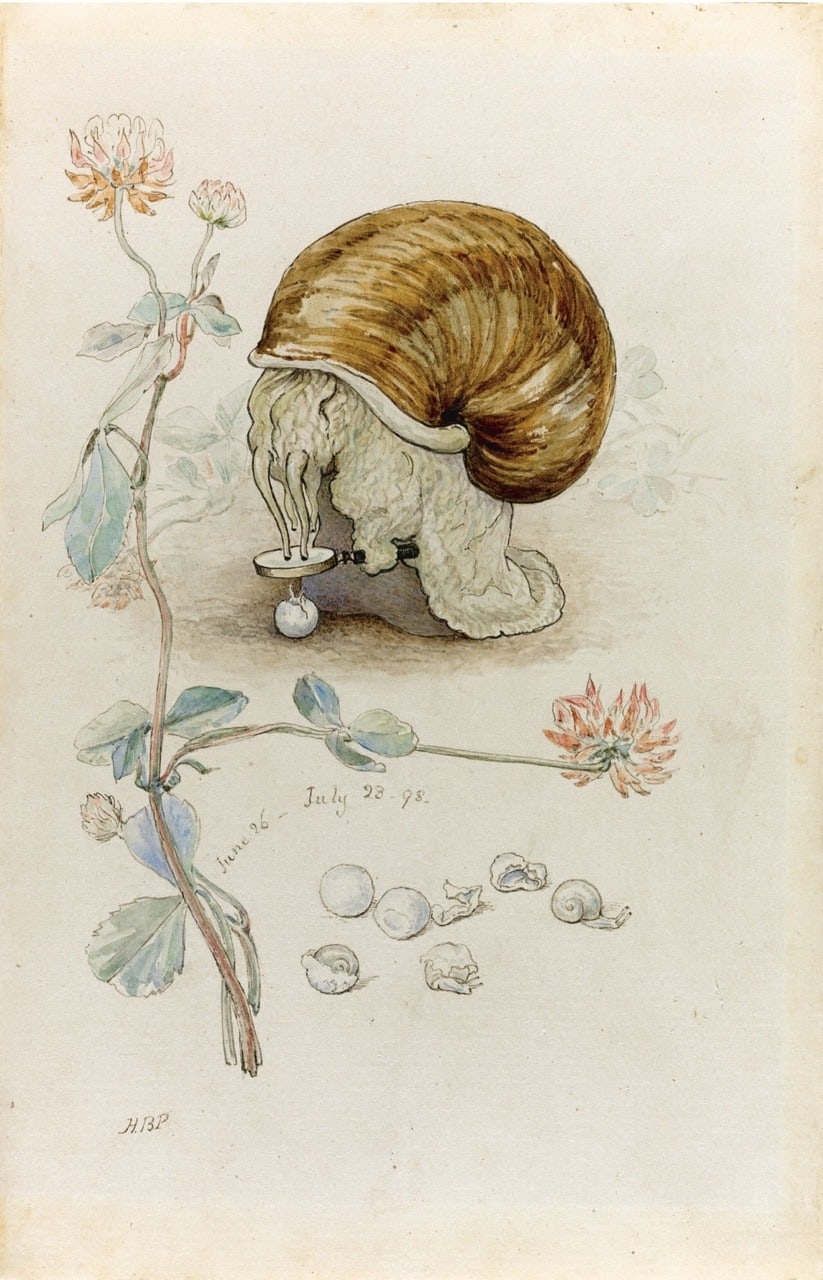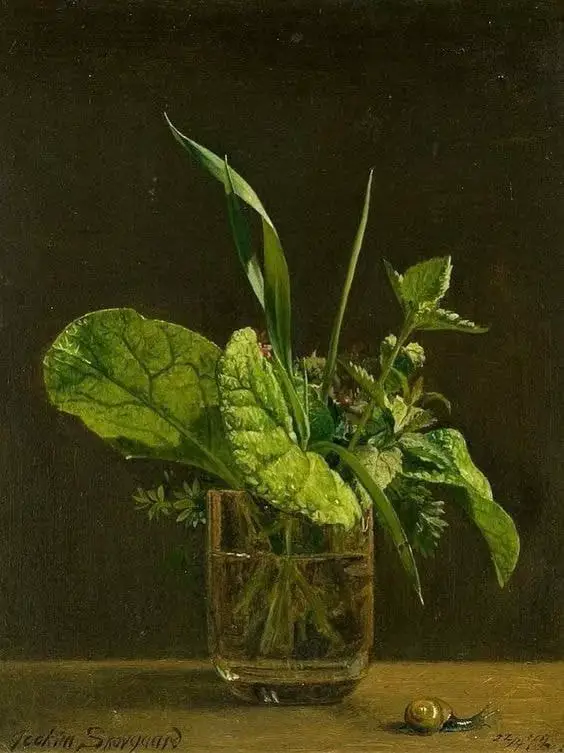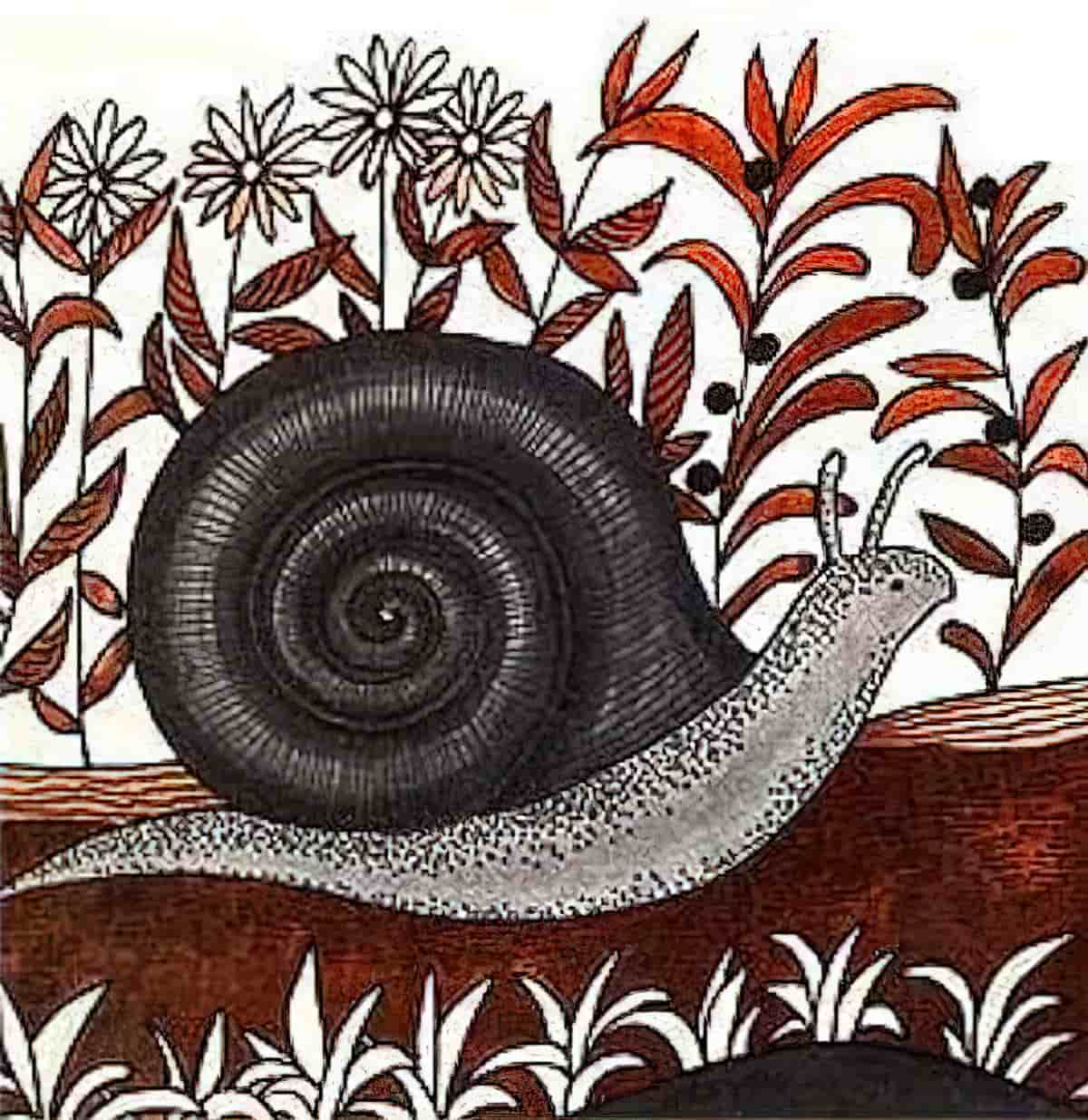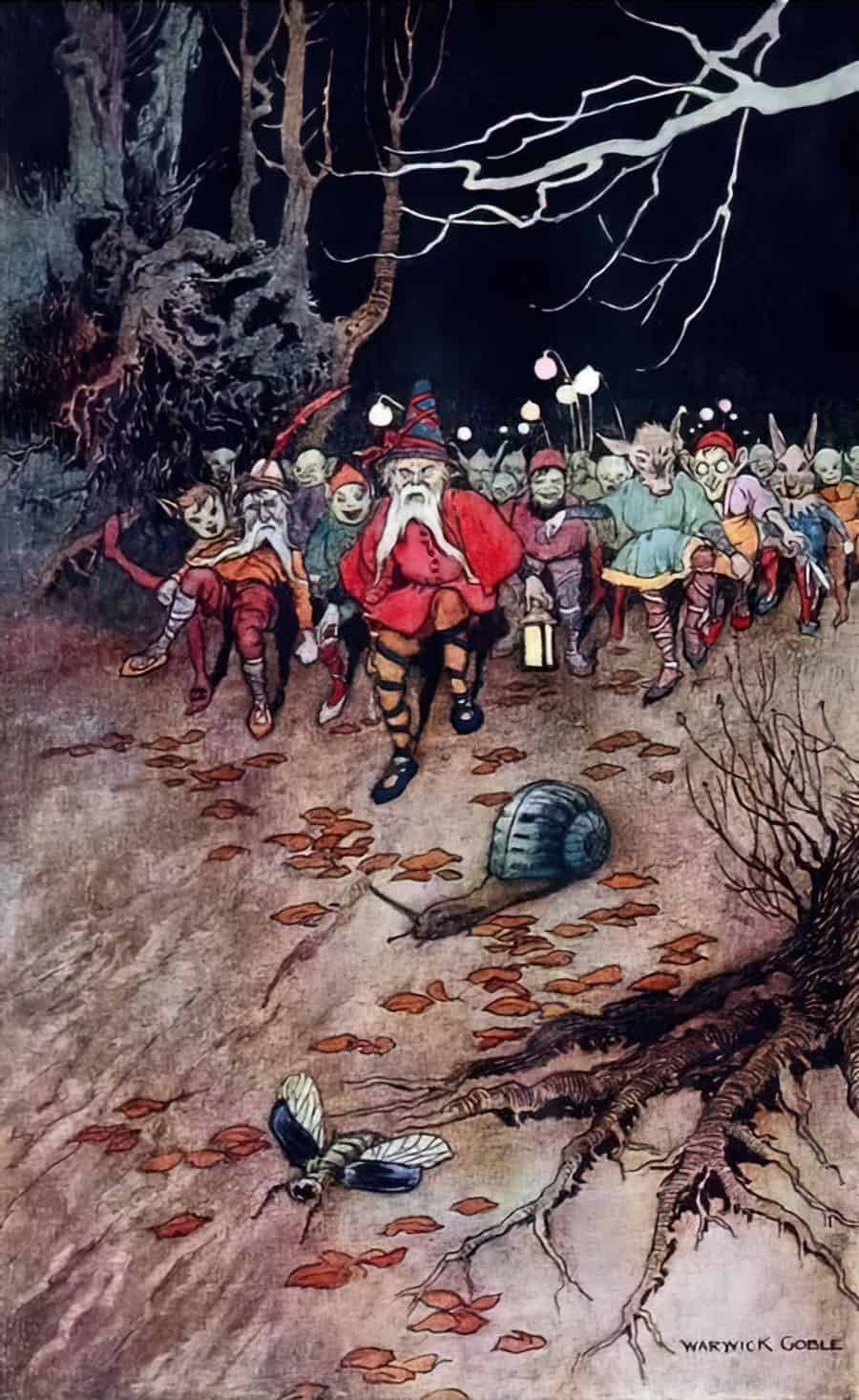In many folktales, visitors to fairyland see magnificent palaces and comely people until they accidentally rub the fairy ointment on their eyes. Then fairyland is revealed as a charnel-house, grey and grim, with the fairies as the grinning dead.
Diane Purkiss, Troublesome Things


The Utopian World is prevalent in contemporary children’s literature. Move into young adult literature, and the top end of middle grade, and settings which looked benign now look not so great. Something is wrong underneath. TV Tropes calls the snail under a leaf setting a False Utopia.

The ‘snail under the leaf’ describes a setting which:
- emphasises the evil of the universe
- and the basic cruelty of life, as a part of the general make-up of humanity.
- ‘The snail underneath the leaf’ setting is also about people’s delusion — we may think everything is hunky dory, but only because we’re not looking under the rotten surface layer.
Snails are widely connected with unpleasantness. Taking a line from the author’s own journals, Katherine Mansfield scholars have called this kind of setting ‘the snail underneath the leaf’. Generally the themes of these narratives focus on corruption of the world, or betrayal of others, whether directly or indirectly. (Katherine Mansfield’s short stories often feature actual snails.) In Mansfield’s later stories the handling of theme grows darker and more despairing.
- In “The Little Governess” the waiter at the hotel destroys the character’s chances of getting the job.
- In “Bliss” Miss Fulton betrays Bertha’s love and the boy and the girl in the park ridicule Miss Brill’s illusion.
The best visual representation of this concept is by Australian picture book creator Shaun Tan:

But in this post I feel a little bad about dismissing snails, so I include art in which the beauty of snails comes to the fore:



What other kinds of stories feature a snail under the leaf setting?
As depicted so clearly in the opening scene to the Netflix series Riverdale, the snail under the leaf setting looks beautiful to the tourist or to the casual observer but awful things are happening just beneath the surface. The voice over which accompanies the opening scene of Riverdale is a perfect description of the utopia which is no such thing.
Blue Velvet (1986) is famous for the utopian opening punctured by death, foreshadowed initially by the gun on the TV screen. Note the white picket fences, the rows of colourful flowers, the manicured lawns. Also the symbolic dream houses. Interestingly, after the man’s death, the camera gives us a macro shot of that perfectly manicured lawn to reveal the wriggling insect life underneath. Insects, snails… it seems life in the undergrowth is symbolically connected to snail under the leaf settings.
Below is a description of Pines, which came through in a BookBub email. The copy describes your classic snail under the leaf setting:
Pines
By Blake CrouchThe Wall Street Journal bestselling mystery that became a hit TV show! Ethan is sent to a small town to locate two missing federal agents — but something terrible is lurking behind its picturesque veneer… “A thrill and surprise on every page” (Hugh Howey)
The Giant African Land Snail can grow up to twenty inches in length. It’s been known to eat over 500 species of plants and is classified as an invasive species. Slow, but hungry… pic.twitter.com/dkfAKQjGin
— Pulp Librarian (@PulpLibrarian) March 10, 2020
A SHORT HISTORY OF SNAIL UNDER THE LEAF SETTINGS
The snail under the leaf setting is a descendent of The Fall plot, which is as old as language itself:
There was once a time when there was no disease. Life spans were longer than those we enjoy today, there was no suffering, and people possessed magical powers. They could fly, go to heaven at will, and understood the language of animals.
This is the myth of the golden age, found in cultures the world over. The oldest stories predate Eden: Sumerian cuneiform tablets speak of Dilmun, ‘a place where sickness, violence and ageing are unknown.’ When the sun-god Utu and Enki, lord of soil and earth, brought water, Dilmun flowered and became a beautiful garden. Another pre-Edenic tale is the ancient Persian story of Yima, the first human. During his time, ‘there was neither heat nor cold, neither old age nor death, nor disease.’ Yima built a beautiful garden, the most widespread image for paradise. This is no coincidence, as Richard Heinberg noted: ‘The word paradise itself comes from the Avestan (Old Iranian) word Pairidaeza, meaning a walled or enclosed garden.’
But then disaster struck. Myths of the fall are as widespread as those of the golden age. In Eden, the Serpent tempted Eve to eat the fruit from the Tree of the Knowledge of Good and Evil. In Persia — one of the few stories not to attribute the loss of paradise to the actions of a woman — the Fall was brought about when Yima refused to do the bidding of Ahura Mazda, the Zoroastrian god. Divine displeasure resulted in shorter life spans, pain, toil, conflict, and disease. We have been living in this world ever since.
A Short History of Disease: Plagues, poxes and civilisations by Sean Martin
The difference between Fall mythologies and the modern snail under the leaf setting is that it is often revealed that the setting was never utopian in the first place — it simply seemed so. In certain genres (like horror) we’ve been primed to expect a happy scene to at some point turn into a terrifying scene. This is why singing in cars while driving along highways scares me.

THE SUBURBS AS APPARENT UTOPIA
Aside from small towns next to lakes and forests, suburbia is a common choice for the snail under the leaf setting.
“They taught us at Barnard about that word, ‘utopia’. The Greeks had two meaning for it: ‘eu-topos’, meaning the good place, and ‘u-topos’ meaning the place that cannot be.”
Rachel Menken, Mad Men, season one, episode 6, “Babylon.”
Mad Men, of course, is a snail under the leaf setting itself, making Rachel’s lines somewhat meta. Mad Men is set partly in Manhattan, partly in the suburbs where Don Draper has bought a big family home, hoping to keep his family safe. Matthew Weiner was influenced by John Cheever when he wrote Mad Men; many of Cheever’s short stories are a story under the leaf stories, set in mid-century American suburbs.
CASE STUDY: INDEPENDENCE DAY BY RICHARD FORD
Here is the opening to Independence Day (1995) by prize-winning American author Richard Ford. This beautiful description of suburban utopia conveys just the right amount of ominous vibes, alerting readers to a Snail Under The Leaf setting:
In Haddam, summer floats over tree-softened streets like a sweet lotion balm from a careless, langurous god, and the world falls in tune with its own mysterious anthems. Shaded lawns lie still and damp in the early a.m. Outside, on peaceful-morning Cleveland Street, I hear the footfalls of a lone jogger, tramping past and down the hill toward Taft Lane and across to the Choir College, there to run in the damp grass. In the Negro trace, men sit on stoops, pants legs rolled above their sock tops, sipping coffee in the growing, easeful heat. The marriage enrichment class (4 to 6) has let out at the high school, its members sleepy-eyed and dazed, bound for bed again. While on the green gridiron pallet our varsity band begins its two-a-day drills, revving up for the 4th: “Boom-Haddam, boom-Haddam, boom-boom-ba-boom. Haddam-Haddam, up’n’at’em! Boom-boom-ba-boom!
Elsewhere up the seaboard the sky, I know, reads hazy. The heat closes in, a metal smell clocks through the nostrils. Already the first clouds of a summer T-storm lurk on the mountain horizons, and it’s hotter where they live than where we live. Far out on the main line the breeze is right to hear the Amtrak, “The Merchants’ Special,” hurtle past for Philly. And along on the same breeze, a sea-salt smell floats in from miles and miles away, mingling with shadowy rhododendron aromas and the last of the summer’s staunch azaleas.
Though back on my street, the first shaded block of Cleveland, sweet silence reigns. A block away, someone patiently bounces a driveway ball: squeak…then breathing… then a laugh, a cough… “All riight, that’s the waay.” None of it too loud. In front of the Zumbros’, two doors down, the streets crew is finishing a quiet smoke before cranking their machines and unsettling the dust again. We’re repaving this summer, putting in a new “line,” resodding the neutral ground, setting new curbs, using our proud new tax dollars — the workers all Cape Verdeans and wily Hondurans from poorer towns north of here. Seargeansville and Little York. They sit and stare silently beside their yellow front-loaders, ground flatteners and backhoes, their sleek private cars–Camaros and Chevy low-riders–parked around the corner, away from the dust and where it will be shady later on.
And suddenly the carillon at St. Leo the Great begins: gong-gong, gong, gong, gong, gong, then a sweet, bright admonitory matinal air by old Wesley himself: “Wake the day, ye who would be saved, wake the day, let your souls be lived.”
[double carriage return]
Though all is not exactly kosher here, in spite of a good beginning. (When is anything exactly kosher?) […]
And so it is in Haddam, where all around, our summer swoon notwithstanding, there’s a new sense of a wild world being just beyond our perimeter, an untallied, apprehension among our re
Independence Day by Richard Ford

FURTHER EXAMPLES OF APPARENT UTOPIAS
American Beauty, the movie, and also Six Feet Under, in a way. A family unit lives upstairs from a literal morgue. The snail under the leaf setting symbolism is exploited most when the house has plumbing issues, spewing forth all sorts of vile liquid back into the family home.
Broadchurch, the British TV series, and pretty much any crime drama set in a picturesque small town, especially if it’s a holiday destination.
Tales From Outer Suburbia, the picture/coffee table book by Shaun Tan is an example often presented to children. (I think Shaun Tan’s picture books have a dual audience.)
Courage The Cowardly Dog, a horror/comedy TV cartoon series, which has fun with a ridiculously isolated prairie setting.

Are You There, God? It’s Me, Margaret by Judy Blume is another example for young readers. In children’s stories, the snail under the leaf setting is often pretty utopian, except for interpersonal issues, extending to bullying.
Pretty Little Liars, based on a series of young adult books, marketed as Desperate Housewives For Teens. Interestingly, when adapted for TV, Pretty Little Liars makes use of many of the same landmarks as Gilmore girls, because they are both filmed in California at the same place.
The Ice House, film from the 1990s based on the Rick Moody novel. Suburban snail under the leaf settings often feature houses made mainly of glass.
Get Out, a 2017 film. A young African-American visits his white girlfriend’s parents for the weekend, where his simmering uneasiness about their reception of him eventually reaches a boiling point.

Anyway, if a story opens with a happy suburban setting, know there’s an ugly, slimy little snail hiding right under the surface.
Like Margaret Simon, I was an only child suspicious of suburban idyll. I consumed the book, as I would go on, in my 20s, to consume anything by Richard Yates or John Cheever, seeking assurances that a lawn was a poor means of generating certain existential satisfactions. The novel [Are You There God? It’s Me, Margaret] begins with its heroine forced to leave Manhattan, with all of its enrichments, when her parents decide to move to the suburbs (for all of the reasons parents have always decided to move to the suburbs). “Please help me God,” Margaret implores. “Don’t let New Jersey be too horrible.”
Ginia Bellafante, NYT
Existentialism: an outlook which begins with a disoriented individual facing a confused world that they can’t accept. Existentialism’s negative side emphasizes life’s meaningless and human alienation. Think: nothingness, sickness, loneliness, nausea.
INVERSIONS OF SNAIL UNDER THE LEAF SETTINGS
The small town which seems picturesque but is actually terrible is so common in story that it’s pretty much expected by the audience. For this very reason, storytellers can subvert that expectation by giving the newcomer a pleasant experience in a new place, even though that character expected the worst.
SUBURGATORY
Suburgatory is a sitcom in which a teenage NYC girl with a superiority complex is forced to move to a nearby suburbs with her dad. She expects the worst — and so do we — because this is a brightly-coloured, well-manicured suburb. The main character does encounter conflict, but not because there is death and destruction lurking under the surface — because the very utopia these people created has magnified their small problems until now they seem very large.
GILMORE GIRLS
This same gag is used in much of the Gilmore girls humour, which revolves around parish pump politics. Refer to Taylor and his town meetings. The inevitable message: Humans can never be happy. Where there is no Minotaur opposition to unify a community, the community will invent conflict, turning against each other. (Of course, there’s no story without conflict.)
SCHITTS CREEK
Schitt’s Creek is a different example of a subverted snail under the leaf setting because the town is not presented as a utopia at all — the set designers went to a lot of trouble to make the town where it’s filmed look a lot worse than it is. Although this small town looks dilapidated on screen, it is revealed to the audience that the people of Schitt’s Creek are warm and friendly. This town looks like it will be full of illiberal bigots, but they embrace sexual diversity. The creators were sure of one thing from the start — they didn’t want any bigotry in this feel good show.
In defence of snails, not everyone finds them unpleasant. The artist below incorporates their beautiful structure into a highly detailed ornamental design.


Everyone knows that magic and trouble go hand in hand…
A dangerous spell cast over an unsuspecting village.
An enchanted painting locked in a hidden room.
A desperate race against time to break the spell before it’s too late…
It should have been a fresh start for the Widdershins. Finally free from the misty gloom of Crowstone and beginning a new life. But all is not as it seems in their postcard-pretty village. Their neighbours are acting strangely, and why do they flinch at the mere mention of magic?
The Widdershins sisters have their own secret: a set of enchanted nesting dolls with the power to render their user invisible. The sisters must use their wits – and their magic – if they’re to break the dark hold over the village, and save one of their own . . . but have they met their match this time?
RELATED TO THE SNAIL UNDER THE LEAF SETTING
- Stepford Suburbia from TV Tropes.
- Dystopias in Fiction
RELATED TO SNAILS
If our sympathy for Ripley has deepened over time, so, perhaps, has our ambivalence about his author [Patricia Highsmith], though her literary star has, quite rightly, only risen in the decades since her death. One of the stranger details in Highsmith’s biography is the fact that she went through a phase in which she carried her pet snails with her to dinner parties in a large handbag (her 1957 novel, “Deep Water,” soon to be a film starring Ben Affleck and Ana de Armas, features a scene in which snails crawl over the murderer’s hands, stately and sinister).
How ‘The Talented Mr. Ripley’ Foretold Our Era of Grifting, NYT




